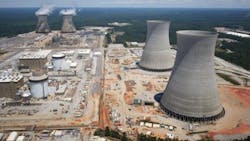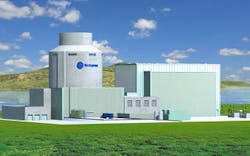Fed Support Could Boost Westinghouse Nuclear Manufacturing by $80B
Longtime reactor designer and manufacturer Westinghouse Electric Co. has weathered the ups and downs of the nuclear energy journey during this century despite some tough breaks.
The nuclear side of Westinghouse has now gained some pivotal good news with a new partnership involving the U.S. government and a key piece of the fuel supply chain.
The federal government is entering into a strategic partnership that could ultimately produce $80 billion worth of new Westinghouse reactor business to boost carbon-free electricity for artificial intelligence (AI) and digital infrastructure deployment across the U.S. and perhaps elsewhere in the world.
The other companies in the collaboration include global uranium fuel producer Cameco Corp. and New York-based investment firm Brookfield Asset Management. Both of those companies own stakes in Westinghouse Electric Co.
“Brookfield has more than half a trillion dollars invested in the critical infrastructure that underpins the U.S. economy, and we expect to double that investment in the next decade as we deliver on building the infrastructure backbone of artificial intelligence,” said Connor Teskey, President of Brookfield Asset Management, in a statement.
Westinghouse is considered one of the national leaders in conventional reactor development. Its two-unit Westinghouse AP1000 project line can deliver reactors capable of gigawatt-scale power and create 45,000 manufacturing and engineering jobs in 43 states, according to the release.
The Trump Administration has issued multiple executive orders promoting new growth in nuclear power to meet energy demand from AI and data centers in the U.S. Some industry forecasters are predicting 125 GW and more in new load from digital infrastructure over the coming decade.
Nuclear fission reactors already account for about 18% of U.S. utility-scale electricity, and close to half of its carbon-free power output. The Trump Administration also is increasing support for small modular reactor development beyond utility-scale units such as Westinghouse’s.
“This historic partnership with America’s leading nuclear company will help unleash President Trump’s grand vision to fully energize America and win the global AI race,” U.S. Secretary of Energy Chris Wright said in a statement. “President Trump promised a renaissance of nuclear power, and now he is delivering.”
The AP1000 is a pressurized water reactor design with some of the passive safety features and modularity in design of prospective SMR units. Westinghouse’s reactors are in operation at the latest U.S. nuclear power plant expansion at the Vogtle station in Georgia, generating close to 1 GW (1,000 MW) per unit.
The Vogtle expansion, finally completed with Unit 4’s commissioning last year, took nearly a decade and was almost derailed by several cost overruns and delays. The troubled construction of reactors 2 and 3 at the Summer Nuclear Station in South Carolina, which was abandoned in 2017 after cost overruns, ultimately led to about $9 billion in losses and the Chapter 11 bankruptcy filing and reorganization by Westinghouse.
Brookfield stepped into an ownership role as Westinghouse emerged from its bankruptcy process in 2018.
About the Author
Rod Walton, EnergyTech Managing Editor
Managing Editor
For EnergyTech editorial inquiries, please contact Managing Editor Rod Walton at [email protected].
Rod Walton has spent 17 years covering the energy industry as a newspaper and trade journalist. He formerly was energy writer and business editor at the Tulsa World. Later, he spent six years covering the electricity power sector for Pennwell and Clarion Events. He joined Endeavor and EnergyTech in November 2021.
Walton earned his Bachelors degree in journalism from the University of Oklahoma. His career stops include the Moore American, Bartlesville Examiner-Enterprise, Wagoner Tribune and Tulsa World.
EnergyTech is focused on the mission critical and large-scale energy users and their sustainability and resiliency goals. These include the commercial and industrial sectors, as well as the military, universities, data centers and microgrids. The C&I sectors together account for close to 30 percent of greenhouse gas emissions in the U.S.
He was named Managing Editor for Microgrid Knowledge and EnergyTech starting July 1, 2023
Many large-scale energy users such as Fortune 500 companies, and mission-critical users such as military bases, universities, healthcare facilities, public safety and data centers, shifting their energy priorities to reach net-zero carbon goals within the coming decades. These include plans for renewable energy power purchase agreements, but also on-site resiliency projects such as microgrids, combined heat and power, rooftop solar, energy storage, digitalization and building efficiency upgrades.


